The first step is to download the actual VM Additions. You can read more about the Linux VM Additions here. To download the additions, you need to log into Microsoft Connect, and the look in the available programs for the Virtual Machine Additions for Linux. Once you download and install the file VMAdditionsForLinux32Bit.MSI, you will have an additional ISO file under C:\Program Files\Microsoft Virtual Server\Virtual Machine Additions\, called VMAdditionsForLinux.iso. This ISO file will appear on the Known image files on the virtual machine’s CD/DVD Drive properties:

Once you mount the ISO, installing the additions is straightforward. You only need to change the directory to the CD-ROM drive from a terminal (in this case, /media/cdrom), and run the script vmadd-install.run. This script takes several parameters, depending on what part of the additions you wish to install. You can, for example, only install the SCSI driver, or the X11 driver, or any other component. I installed all of them using the command line ./vmadd-install.run all:
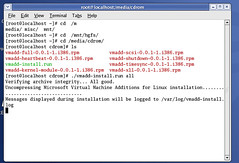
You can also install the additions using the RPM packages, if your distro supports it. Once the additions were installed, the VM worked like a charm. The mouse integration works perfectly, and the performance increase is noticeable.
As suggested in this post by Christian, I went ahead and downloaded the vmdk2vhd utility to convert virtual hard drives from VMWare’s VMDK format to Microsoft’s VHD format. To test it out, I also downloaded Red Hat Enterprise Linux trial virtual appliance from VMWare’s site, and ran the converter on it. These are my results.
First, running the converter is pretty straightforward. You just launch the utility, and it presents you with a simple UI, where you select the vmdk you want to convert, and the path to the destination VHD.
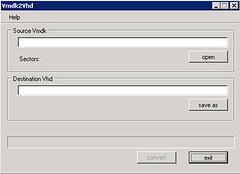
Once you select the vmdk and the vhd, press the convert button to start the conversion process:
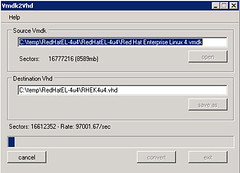
The tool shows you a dialog box when it completes the conversion:
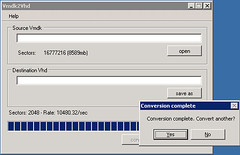
I created a new virtual machine in Virtual Server 2005 R2 SP1 Beta 2 using this newly converted VHD, and, not knowing what to expect, I started it. The redhat OS started the boot up process normally:
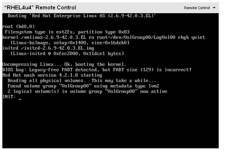
After making some adjustments to the configuration, including the X Server configuration, I finally got the X Windows server to come up. I am currently playing with the OS, and will proceed to install the VM Additions … I will document the process in another post soon.
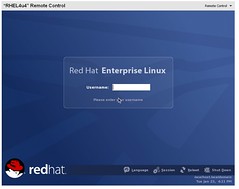
As you can see, the process for converting a VMWare virtual hard disk to a Virtual Server VHd is very straightforward. This will work, ideally, in a migration scenario, but this also enables a scenario to try out the large amount of Virtual Appliances that you can download from VMWare’s website.
Virtual PC 2007 has moved to the Release Candidate stage. You can download it from here.
You can also check out the new features of this release on the Virtual PC Guy's WebLog .
Over at IBM developerworks there is an overview of virtualization technologies, starting with the history of virtualization, virtualization methods, and some more information on the current status of virtualization in the IT industry. The article focuses on Linux Virtualization solutions, but the information it contains and the background it gives is worth a read.
Link: Virtual Linux.
This post is the second part on the comparison between Virtual Server 2005 R2 SP1 and Windows Virtualization:
- Cluster Support: Both Virtual Server and Windows Virtualization have support for Windows Server clustering
- Scripting support: Both Virtual Server and Windows Virtualization have support for scripting, but Virtual Server uses a COM API and Windows Virtualization a WMI-based API
- Supported VMs: Virtual Server, with SP1, support up to 128 VMs on a single server. Windows virtualization supports as many as the hardware allows.
- Management Interface: Virtual Server has web-based administration tools. Windows Virtualization, on the other hand, will be managed through a MMC snap-in, to put it in line with all other Microsoft’s management solutions.
You can check out the first part here.
Several times I've been asked something along the lines of “why should I install virtual machine additions on a virtual machine? The virtual machine works fine without them, doesn't it?". I thought it is worth it to quickly mention the benefits of virtual machine additions in this post.
The Virtual Machine Additions included with Virtual Server perform several tasks. They allow better communication between Virtual Server and the guest OS, on things such as time synchronization or the ability to shut down the machine on command. But the most important task performed by the Additions is that they patch the operating system so it can work with what is called Ring Compression.
Operating systems normally run on Ring 0 on x86 CPUs. Ring Compression allows the virtual machine OS to run on Ring 1 on the hardware, allowing the host operating system and the virtual machine monitor to run on Ring 0. By using ring compression, the VMM is able to trap instrucions from the virtual machine that otherwise it is unable to catch – such as memory requests. The alternative, at least in Virtual PC (I’m not 100% possitive Virtual Server follows the same approach) is to run the operating system instructions not on the hardware, but on a binary translator. This is the one of the reasons why after installing the additions you see such an increase in the virtual machine’s performance.
Of course, ring compression is not necessary if you have a CPU with AMD-V or Intel VT technology. In those CPUs, the virtual machine monitor runs on a Ring -1, so guest operating system will run on Ring 0 without any complications.
You can read more about this topic here or here.
Windows Virtualization is the next generation of virtualization solutions offered by Microsoft. Here is a quick list on how it compares to Virtual Server 2005 R2 SP1:
- Supported Hardware: Virtual Server 2005 R2 SP1 runs on both x86 and x64 architectures. Windows Virtualization will be x64 ONLY.
- Virtual Machine Support: Virtual Server supports 32–bit virtual machines. Windows Virtualization supports both 32 and 64–bit Virtual Machines
- Virtual Machine Memory Support: Virtual server can allocate up to 3.6GB per VM. Windows Virtualization will be able to assign up to 32GB per VM
- Hot add: Virtual Server does not support adding hardware to a virtual machine while it is running. Windows Virtualization supports hot add of memory, processors, storage, and networking devices.
A couple of weeks ago, during the Virtualization for Developers event in Redmond, we had a short presentation on Viridian by Arno Mihm, Program Manager for Windows Virtualization. He explained the features that will be available on that platform, the differences with the current Virtual Server architecture, and also talked a little bit about the hypervisor.
Windows Virtualization is coming up with some pretty impressive features. The Windows Hypervisor is a tiny piece of code (right now it is around 160KB… it has grown, though, since it was 140KB when we first heard about it on the Longhorn Developer Review back in April), that manages the different partitions running on the physical computer. Microsoft has taken an intelligent approach at this level. The hypervisor only manages context switches between the VMs and protects access to the different VM’s resources. All device drivers and any other logic are managed by the parent OS. This way the hypervisor code can remain really small and extremely fast, and provide the type of reliability that is necessary for this type of environment.
Another nice feature of Windows Virtualization is the device driver architecture. “Enlightened” operating systems will route all device requests through Virtualization Service Clients, that through a very efficient communication mechanism (called VMBus) will communicate directly with Virtualization Service Providers on the parent partition of the server, and then call the hardware directly. This is more efficient than current implementations, in which calls to virtual devices are trapped and handled through the virtual machine worker processes, requiring several context switches in the process.
The best part of the presentation, however, was to finally get to see Windows Virtualization in action. He did a short demo on his laptop, that had a preliminary build of Longhorn server with the Hypervisor enabled. One of the virtual machines was also running Longhorn server, and he showed us how you can dynamically add memory to a virtual machine, WHILE THE VM IS RUNNING, and the client operating system (Longhorn server in this case) will pick it up immediately. This is very useful for those times when you need to give an extra boost to a virtual machine so it can complete a certain task. And my understanding is that all new server products from Microsoft (starting with Exchange 2007) will be able to dynamically pick up these changes as well.
Over at the Virtually vista blog there’s a post talking about how to run the RTM of Vista in a virtual machine. Regarding the supported products and additions, the post states:
If you're using Virtual PC, you should be using the VPC 2007 Beta - the additions that ship with that product work just fine in Vista.
If you're using Virtual Server, you should use the VS 2005 R2 SP1 Beta - those additions work with Vista as well.
The only downside we've found with running Vista on a VM is that the precompactor doesn't work - and Vista uses a lot of disk space during the installation, so we haven't been able to compact a dynamic VHD with Vista.You can get both VPC 2007 and Virtual Server 2005 R2 SP1 Beta form http://connect.microsoft.com.
Last week we succesfully delivered the first in the series of virtualization events aimed at developers creating software to work with Virtual Server 2005. Even though we didn’t get as much of a turnout as we were expecting, the event was a complete success. Also, the feedback we got for both the content and the presentation was excellent!
I encourage you to register for one of these events. The next one is in Zaragoza on Jan 23–25. The next US event will be again in Redmond, on Feb 6–8. Don’t miss them!